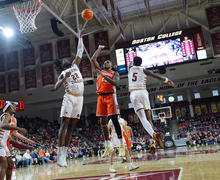Students, faculty reflect on SU’s refreshed Academic Strategic Plan
Maxine Brackbill I Asst. Photo Editor
Faculty are reflecting on the Academic Strategic Plan as the fall semester comes to a close.
Get the latest Syracuse news delivered right to your inbox.
Subscribe to our newsletter here.
Tula Goenka was skeptical going into the initial preparation for Syracuse University’s Academic Strategic Plan. Having worked at SU for 27 years, she said she’s been a part of previous plans where there wasn’t much interaction among the university community.
But after months of work serving as a member of the Global Engagement working group, Goenka said her skepticism turned into excitement.
The ASP, a long-term plan that outlines the university’s academic goals, identifies and works in categories such as educational excellence and public impact, according to an SU News release. Chancellor Kent Syverud introduced the early stages of the ASP in September at a launch forum, where he explained the plan’s timelines, its working groups and their campus conversations.
Goenka is among other faculty and staff who serve on a total of seven working groups that collected feedback from university students, faculty and staff.
“It was a thrill and a joy to be in the global engagement work group,” Goenka said. “I felt like ‘yes, we can do something,’ and I think for me, the way it was designed was really great.”
Over the course of the fall semester, SU provided various opportunities to encourage students to submit their feedback, including student engagement sessions, a campus forum at the Schine Center and meetings with student organizations like the Student Association.
Gretchen Ritter, SU’s vice chancellor, provost and chief academic officer, described the ASP planning process as intense, inspiring and humbling. She attributed increased student participation throughout the semester to the process’ efforts to meet in popular student locations on campus like the Schine Student Center.
“We were pleased and excited at the launch forum and the engagement we saw there,” Ritter said. “We weren’t quite sure whether that would remain the case. Much to our amazement, the level of our engagement increased.”
SU hosted 65 events with over 1,600 university students, faculty and staff participating as part of the planning process for the ASP in the fall semester, according to a news release.
Marcelle Haddix, SU’s associate provost for strategic initiatives, said she believes SU students have felt a sense of responsibility for building up the future of the university throughout the process, and that it was empowering to see the level of engagement from students. SU’s Vice President for Enrollment Services Ryan Williams added that he was impressed specifically with students having a “keen interest” in the quality and diversity of the incoming classes.
Many students prioritized the ASP planning process throughout the fall semester.
Micah Goldstein, a senior majoring in broadcast and digital journalism, said he followed the latest news on the ASP through conversations in class and with his academic advisor about his “roadmap” to success. He said the ASP has helped to formulate steps for success at SU both for current students and alumni.
“The roadmap that each student can follow is tailored to maximize their strengths and compensate for their weaknesses,” Goldstein said.
Student engagement inspired the members of the working groups, said Jamie Winders, SU’s associate provost for faculty affairs.
The development process for drafting a refreshed ASP will take place over the holiday break, Ritter announced at a November University Senate meeting.
The ASP will be circulated among the co-chairs of the working groups and a select number of individuals in January, Ritter said. In early February, she said it’s set to be circulated across the rest of the SU community before its implementation at the end of the spring 2023 semester.
Goenka said she’s excited about where the plan is right now.
“I’m actually really hopeful that this is a strategic plan that the entire campus can get behind… I think the design is much more interactive, and I think I’m much more hopeful,” said Goenka. “I think this time around, it just seemed more organic to me.”
Published on December 7, 2022 at 12:02 am
Contact Dominic: dcchiapp@syr.edu | @DominicChiappo2






